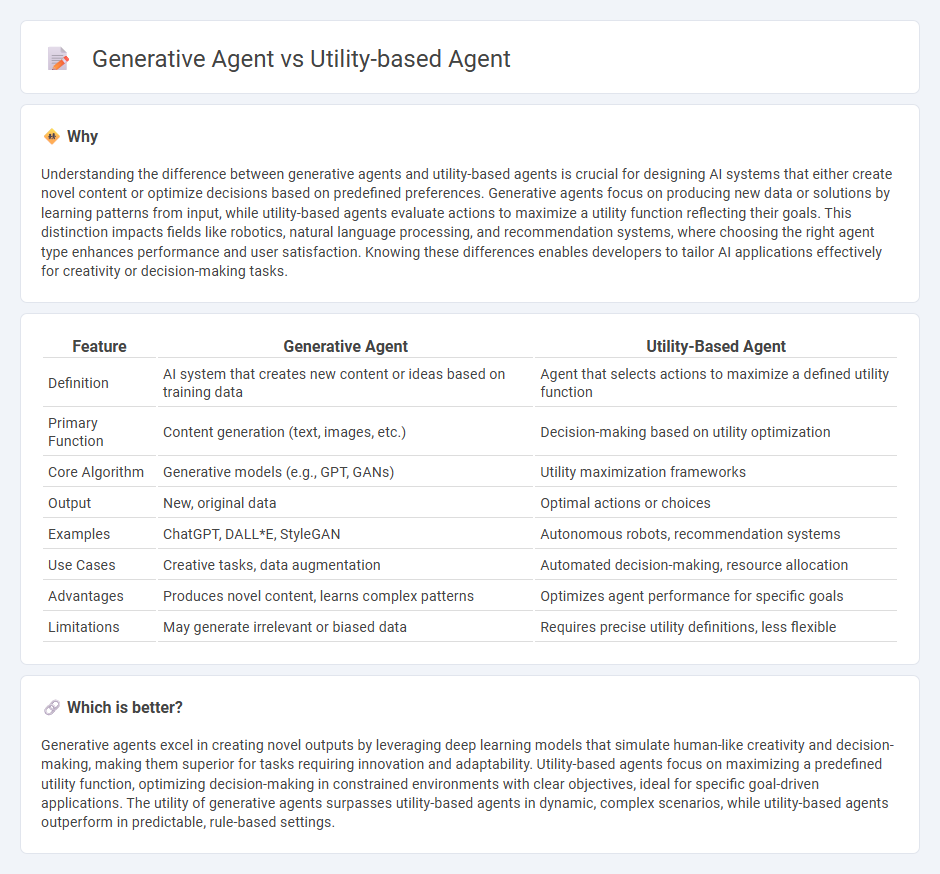
Generative agents leverage machine learning to create novel content or solutions by interpreting data patterns, enhancing creativity and adaptability in technology applications. Utility-based agents focus on decision-making by maximizing a utility function that quantifies preferences, optimizing performance in complex environments. Explore the distinctions and applications of these innovative agent types to understand their impact on advancing artificial intelligence.
Why it is important
Understanding the difference between generative agents and utility-based agents is crucial for designing AI systems that either create novel content or optimize decisions based on predefined preferences. Generative agents focus on producing new data or solutions by learning patterns from input, while utility-based agents evaluate actions to maximize a utility function reflecting their goals. This distinction impacts fields like robotics, natural language processing, and recommendation systems, where choosing the right agent type enhances performance and user satisfaction. Knowing these differences enables developers to tailor AI applications effectively for creativity or decision-making tasks.
Comparison Table
| Feature | Generative Agent | Utility-Based Agent |
|---|---|---|
| Definition | AI system that creates new content or ideas based on training data | Agent that selects actions to maximize a defined utility function |
| Primary Function | Content generation (text, images, etc.) | Decision-making based on utility optimization |
| Core Algorithm | Generative models (e.g., GPT, GANs) | Utility maximization frameworks |
| Output | New, original data | Optimal actions or choices |
| Examples | ChatGPT, DALL*E, StyleGAN | Autonomous robots, recommendation systems |
| Use Cases | Creative tasks, data augmentation | Automated decision-making, resource allocation |
| Advantages | Produces novel content, learns complex patterns | Optimizes agent performance for specific goals |
| Limitations | May generate irrelevant or biased data | Requires precise utility definitions, less flexible |
Which is better?
Generative agents excel in creating novel outputs by leveraging deep learning models that simulate human-like creativity and decision-making, making them superior for tasks requiring innovation and adaptability. Utility-based agents focus on maximizing a predefined utility function, optimizing decision-making in constrained environments with clear objectives, ideal for specific goal-driven applications. The utility of generative agents surpasses utility-based agents in dynamic, complex scenarios, while utility-based agents outperform in predictable, rule-based settings.
Connection
Generative agents create new content or solutions by modeling and simulating human-like behaviors, relying on data-driven algorithms. Utility-based agents make decisions by evaluating and maximizing a utility function to achieve their goals efficiently. Both agent types integrate artificial intelligence principles where generative agents produce options and utility-based agents select the optimal choice based on predicted outcomes.
Key Terms
Utility Function
Utility-based agents rely on a utility function that quantifies the desirability of different outcomes, guiding decision-making by selecting actions that maximize overall utility. Generative agents use models to simulate and predict future states, enabling more flexible and adaptive behavior beyond fixed utility evaluations. Explore the distinctions between these agent types and their applications in artificial intelligence systems.
Decision-Making
Utility-based agents make decisions by evaluating actions against a predefined utility function that quantifies preferences and selects the option that maximizes expected utility, ensuring optimal choices under uncertainty. Generative agents use learned models to simulate potential future scenarios and generate behaviors that align with complex objectives, enabling flexible and adaptive decision-making in dynamic environments. Explore the distinctions and applications of both agents to enhance AI decision-making frameworks.
Generative Modeling
Generative agents leverage generative modeling to create complex, realistic outputs by learning underlying data distributions, enabling applications like image synthesis and natural language generation. Utility-based agents make decisions by maximizing a predefined utility function, focusing on achieving specific goals rather than generating new content. Explore the key differences and advantages of generative modeling in building adaptive AI systems.
Source and External Links
What Are Utility-Based Agents? | TEDAI San Francisco - Utility-based agents are AI systems that maximize a specific utility function, choosing actions that lead to the best overall outcome rather than simply achieving a predefined goal, making them adaptable for complex environments like energy management or autonomous systems.
Understanding Utility Agents In AI: Exploring Types ... - A utility-based agent evaluates actions by their expected utility, using a utility function to rank outcomes and make rational decisions, thus enabling adaptability and optimization in fields like robotics, gaming, and autonomous vehicles.
Understanding Utility-Based AI Agents and Their Applications - Utility-based agents make decisions by predicting outcomes, assigning utility values, and selecting the action that maximizes utility, allowing them to handle uncertainty, balance trade-offs, and improve their choices over time with learning mechanisms.
 dowidth.com
dowidth.com